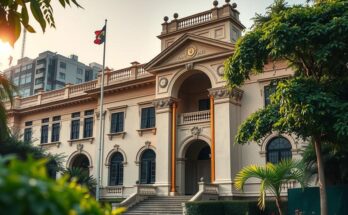Morocco’s urbanization and tourism growth, particularly post-2022 World Cup, are leading to the demolition of traditional artisan communities, with local businesses struggling amidst redevelopment. Projects aimed at eco-tourism and urban renewal often marginalize residents, leaving them without adequate compensation or space to operate. This trend raises urgent calls for a more inclusive approach to urban development, balancing modern demands with the rights of local populations.
Morocco, renowned for its traditional allure, is increasingly witnessing the demolition of towns to facilitate modern urban projects, often neglecting the impact on local communities. The nation has gained popularity as a tourist destination following a notable performance in the 2022 World Cup, attracting 17.4 million tourists in 2024, significantly exceeding projected goals. This influx has placed immense pressure on urban areas, contributing to an 8.8% population growth from 2014 to 2024, which is now 36.8 million.
Efforts to meet tourism demands have led to extensive redevelopment across Morocco. Major projects, such as a billion-dollar eco-tourism resort in Taghazout Bay and urban renewal initiatives in Rabat, aim to enhance economic activity. However, local artisans face significant challenges as they compete with new hotels for space, particularly in historically significant areas such as Oulja, once recognized for its artisanal shops before its demolition for redevelopment.
Local artisans have endured the harsh consequences of these developments, with many having to relocate to less vibrant temporary sites. One artisan described the stark contrast between the lively atmosphere of the old Oulja and his current sterile environment, stating, “This is all I have left to sell and I don’t think it will last even one year.” Others lament the inadequate time to prepare for their displacement, resulting in loss of materials and equipment.
Morocco’s urbanization includes the rise of eco-cities, posing significant urban governance challenges and social inequality. Experts emphasize the need for improved community involvement in development decisions. New projects often displace residents without adequate compensation, as seen in Zenata, where families have lost homes without sufficient financial support. A local resident expressed dismay at receiving payment well below the value of her property, proclaiming, “The money they gave us is not even enough to buy a small house, they violated us.”
Government-funded initiatives also face scrutiny. Previous eco-projects, such as Tamesna and Marchica Lake, have seen little success, often leading to environmental degradation. Issues such as pollution and inadequate infrastructure have arisen, prompting local residents to criticize the negative outcomes of these developments. One resident noted the detrimental environmental impact caused by construction activities, stating, “The whole project is a disaster. The new builds along the waterfront are dumping waste into the lake.”
In conclusion, Morocco’s rapid urban and tourist development has largely overlooked the needs and plights of local communities. The ongoing trends of displacement, inadequate compensation, and the negative impacts on the environment underscore the necessity for more inclusive and sustainable planning strategies. Experts advocate for a participatory approach to urban development, ensuring local voices are heard and considered in future projects.
The development endeavors in Morocco highlight significant challenges faced by local communities impacted by urbanization and tourism growth. Amidst the ambition for modernity, the struggles of displaced artisans and residents raise critical questions about inclusivity in policymaking. Efforts at sustainable urban planning need to prioritize the welfare of local populations, ensuring that their needs and rights are respected and accommodated in future developments.
Original Source: www.middleeasteye.net




